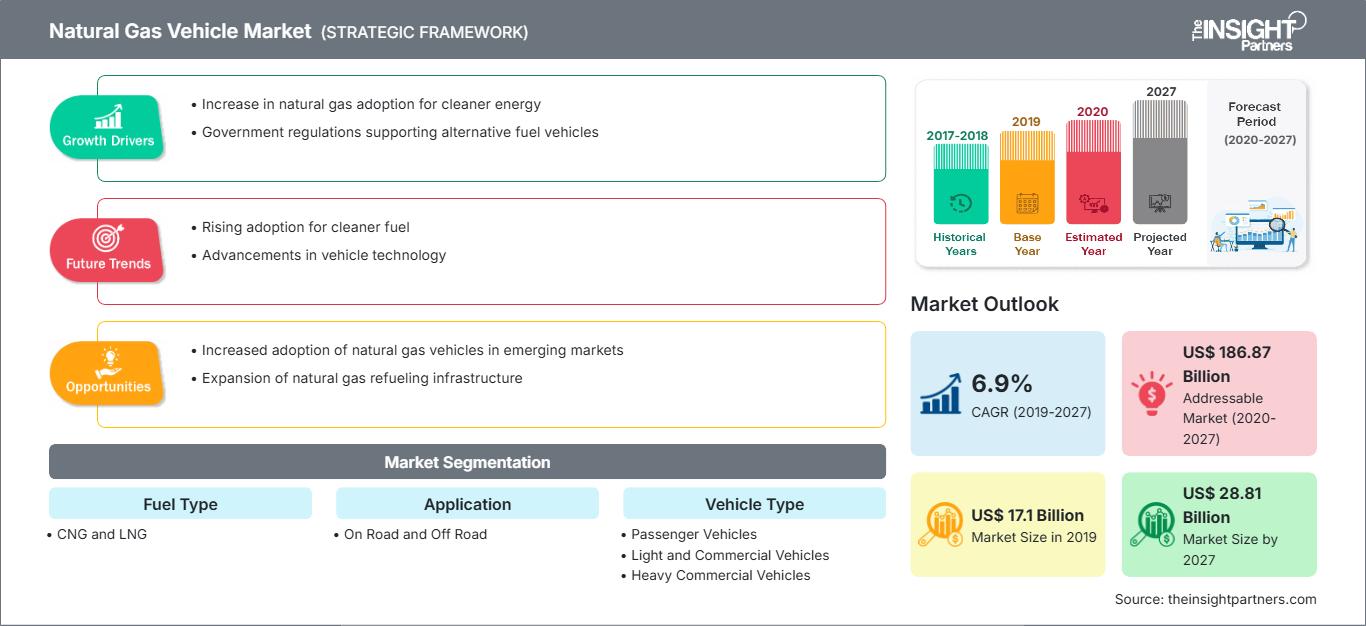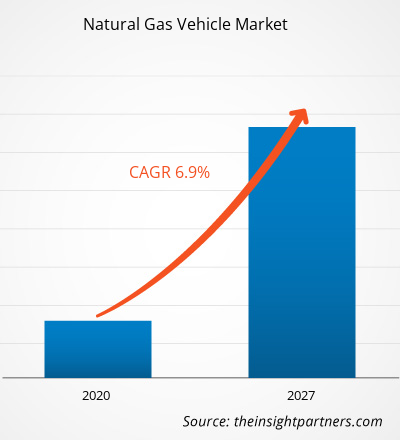2019 年天然气汽车市场价值为 171 亿美元,预计到 2027 年将达到 288.0575 亿美元;预计 2020 年至 2027 年期间的复合年增长率为 6.9%。
天然气汽车发动机的功能类似于通常为火花点火内燃机的汽油动力汽车发动机。天然气储存在气缸或油箱中,通常嵌入车辆后部。电池为这些车辆中的发动机和电力电子设备提供电力。电子控制模块 (ECM) 控制点火正时、燃料混合和排放系统;它还可以观察车辆的运行情况并检测问题。天然气是一种环保燃料,因为它对污染的贡献小于汽油或柴油,并且其资源在世界各地广泛存在。此外,使用天然气汽车的潜在益处包括减少温室气体排放、降低成本、降低噪音和改善当地空气质量。根据气候技术中心与网络 (CTCN) 的数据,压缩天然气 (CNG) 在全球被广泛用作汽车燃料。CTCN 表示,全球约有 75 个国家拥有约 1000 万辆天然气驱动汽车和约 15000 个 CNG 加气站。在天然气储量丰富而石油储量有限的国家,在交通运输中使用天然气可以降低对昂贵石油进口的依赖。全球天然气汽车市场目前是一个利基市场,因为目前少数国家的天然气在公路运输中的份额较小。使用 CNG 汽车的主要国家是巴基斯坦、阿根廷、伊朗和巴西。
建立天然气汽车市场可能需要对汽车进行大量投资并增加政府支持,因为许多国家在普及率较低的情况下不太可能建立天然气汽车市场。全球汽车行业蓬勃发展,乘用车和商用车产量迅速增长。此外,将天然气的益处扩展到汽车行业以外的更广泛的行业,将吸引更多对天然气供应输配电网的投资。
自定义此报告以满足您的要求
您将免费获得任何报告的定制,包括本报告的部分内容,或国家级分析、Excel 数据包,以及为初创企业和大学提供超值优惠和折扣
天然气汽车市场: 战略洞察

-
获取本报告的主要市场趋势。这个免费样本将包括数据分析,从市场趋势到估计和预测。
COVID-19 疫情对天然气汽车市场的影响
汽车制造和运输行业严重依赖体力劳动。由于全球大多数国家实施了严格的封锁规定,该行业在各自制造工厂的劳动力数量大幅减少。这一因素阻碍了汽车和运输行业的发展,从而抑制了天然气汽车市场的增长。由于政府加大对天然气汽车基础设施建设的支持力度,美国是天然气汽车的主要市场。该国确诊病例和报告死亡人数的迅速增加对汽车和运输行业产生了不利影响。美国、加拿大和墨西哥的工厂和企业关闭限制了对天然气汽车的需求。北美拥有大量制造业和汽车公司;因此,COVID-19 疫情对北美市场的影响相当严重,并且很可能在 2021 年持续下去。
市场洞察–天然气汽车市场日益受到政府重视,加强能源安全
能源安全意味着持续获得具有成本效益的能源。它具有诸多特点,例如长期能源安全主要体现在及时投资,以确保能源供应符合环境需求和经济发展水平。短期能源安全则取决于能源系统对供需平衡意外变化的快速反应能力。巴基斯坦政府通过各种政策措施鼓励在交通运输行业引入和发展压缩天然气 (CNG) 应用。巴基斯坦道路上行驶着大量天然气汽车(约 200 万辆),每年消耗 25 亿立方米 (BCM) 的天然气。亚洲各国,尤其是印度,已在石油、天然气、煤炭和电力领域推行了重要的能源定价改革,这对于进一步开放能源市场和增强财政健康至关重要。印度已采取切实措施,通过促进天然气汽车的国内生产来增强其能源安全。随着人们对使用化石燃料对环境的影响以及能源网优势的日益关注,工程师们正在逐步采用能源存储解决方案,从而推动能源安全行业的发展。采用天然气作为运输燃料来降低碳排放,有助于实现可持续发展目标,同时解决全球能源安全问题。因此,各国政府对加强能源安全的关注度不断提升,推动了天然气汽车市场的增长。
基于燃料类型的洞察
根据燃料类型,天然气汽车市场分为压缩天然气 (CNG) 和液化天然气 (LNG)。由于天然气汽车数量的增加以及全球范围内对 CNG 汽车的日益青睐,CNG 汽车市场继续见证着丰厚的利润。此外,汽车行业的增长也影响着 CNG 汽车的普及。
基于应用的洞察
根据应用,天然气汽车市场分为公路汽车和非公路汽车。2019 年,公路汽车市场占据了主导地位。天然气主要用于发电以及住宅、商业和工业用途。它被用作道路车辆的燃料,尤其是在集中加油车队中的中型或重型车辆。此外,也有人提议将其更广泛地用作道路车辆的燃料,尤其是轻型车辆。
基于车辆类型的洞察
根据车辆类型,天然气汽车市场细分为乘用车、轻型商用车和重型商用车。2019年,乘用车细分市场占据市场主导地位。乘用车是印度CNG和LPG汽车市场的领先细分市场。印度顶级汽车制造商更注重天然气汽车的开发,而非电动汽车。由于人均收入的增长和对豪华汽车的需求,乘用车的需求正在增长。公众对天然气乘用车的接受度和政府的大力支持将推动天然气汽车市场的增长。
天然气汽车市场区域洞察
The Insight Partners 的分析师已详尽阐述了预测期内影响天然气汽车市场的区域趋势和因素。本节还讨论了北美、欧洲、亚太地区、中东和非洲以及南美和中美洲的天然气汽车市场细分和地域分布。
天然气汽车市场报告范围
| 报告属性 | 细节 |
|---|---|
| 市场规模 2019 | US$ 17.1 Billion |
| 市场规模 2027 | US$ 28.81 Billion |
| 全球复合年增长率 (2019 - 2027) | 6.9% |
| 历史数据 | 2017-2018 |
| 预测期 | 2020-2027 |
| 涵盖的领域 |
By 燃料类型
|
| 覆盖地区和国家 |
北美
|
| 市场领导者和主要公司简介 |
|
天然气汽车市场参与者密度:了解其对业务动态的影响
天然气汽车市场正在快速增长,这得益于终端用户需求的不断增长,而这些需求的驱动因素包括消费者偏好的转变、技术进步以及对产品优势的认知度的提升。随着需求的增长,企业正在扩展产品线,不断创新以满足消费者需求,并抓住新兴趋势,从而进一步推动市场增长。

- 获取 天然气汽车市场 主要参与者概述
市场参与者专注于新产品创新和开发,通过将先进技术和功能集成到产品中来与竞争对手竞争。
- 2020 年,Agility Fuel Solutions 敦促印度汽车和车队行业实施 CNG 长途旅行解决方案。印度石油和天然气部长在由印度最大的 CNG 分销公司 Indraprastha Gas Limited (IGL) 领导的战略计划下推出了印度首款长途压缩天然气 (CNG) 公交车。
- 2020 年,PACCAR Inc. 被环境报告公司 CDP 评为全球环境实践领导者。该公司凭借其商用车业务和全球设施中一流的信息披露和温室气体减排能力而入选榜单。
天然气汽车市场 —按燃料类型
- CNG
- LNG
天然气汽车市场 - 按应用
- 公路
- 非公路
天然气汽车市场 - 按车辆类型
- 乘用车
- 轻型商用车
- 重型商用车
天然气汽车市场 - 公司简介
- 沃尔沃集团
- Agility Fuel Solutions LLC
- 美国本田汽车公司
- CNH Industrial NV
- Cummins Westport
- 通用汽车
- Navistar Inc.
- Paccar Inc.
- 福特汽车公司
- 大众汽车公司
- 历史分析(2 年)、基准年、预测(7 年)及复合年增长率
- PEST和SWOT分析
- 市场规模、价值/数量 - 全球、区域、国家
- 行业和竞争格局
- Excel 数据集
近期报告
相关报告
客户评价
购买理由
- 明智的决策
- 了解市场动态
- 竞争分析
- 客户洞察
- 市场预测
- 风险规避
- 战略规划
- 投资论证
- 识别新兴市场
- 优化营销策略
- 提升运营效率
- 顺应监管趋势






















 获取免费样品 - 天然气汽车市场
获取免费样品 - 天然气汽车市场